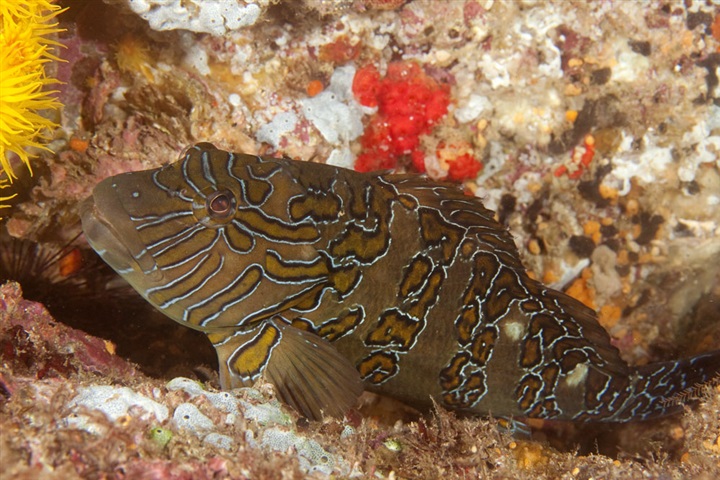Cirrhitus rivulatus

| Latin name | Cirrhitus rivulatus - Valenciennes, 1846 |
|---|---|
| Local name | Giant hawkfish |
| Family | Cirrhitidae - Cirrhitus |
| Origin | East Pacific |
| Max length | 60 cm (23.6") |
| Minimum volume |
600 l (158 gal) |
|---|---|
| Hardiness |
Hardy |
| Suitable for aquarium |
Suitable with care |
| Reef safe |
Reef safe with caution |
| Aggressiveness | Might be aggressive towards other species |
| Recommended |
Fish Larger crustaceans (Shrimp, crabs...) Small crustaceans (Krill, mysis, artemia...) |
|---|
This spicies might be a threat to smaller fishes.
This species poses a threat towards shrimps and crabs etc., which are relatively small.
These fish flourish better without other members of the same species in the aquarium.
This species needs good hiding places, for example, between live rocks.
This species is nocturnal and therefore the most active when the light is dimmed or turned off.
Hawkfish stay still and wait for food most of the time, they are therefore suitable for smaller aquaria.
One must be aware that Hawkfishes can be very aggressive.
Very aggressive genera
The very aggressive species will sometimes attack many different types of fish, even the ones that are larger than themselves.
Cirrhitops
Cirrhitus
Paracirrhtes
Semi aggressive genera
The semi aggressive species are most threatening towards fish whose behaviour mimcks their own, and fish which are introduced after they have settled in.
Cirrhitichthys
Less aggressive genera
The less aggressive species are rarely threatening towards fish that which do not resemble them.
Cyprinocirrhites
Neocirrhites
Oxycirrhites
Larger Hawkfishes might eat small fish, shrimps etc. in the aquarium. Species of the Cyprinocirrhites and Neocirrhites genera are least likely to eat shrimps etc.
Hawkfish do not place many demands on their surroundings or water quality, as they are fairly hardy.
It is possible to keep several Hawkfish together, but sometimes they will suddenly begin to fight after some time in the aquarium.
This may be due to them changing gender so one can end up with two males.
| Aquarium trade | No |
|---|---|
| Distribution | Eastern Central Pacific: Gulf of California to northern Colombia and the Galapagos Islands. |
| Danish common names |
Stor falkefisk |
Scott W. Michael. 2001. Basslets, Dottybacks & Hawkfishes: v. 2 (Reef Fishes) - TFH Publications / Microcosm Ltd. - (English)
James W. Fatherree. The Hawkfishes - Reefs Magazine - (English)
Bob Fenner. Hawkfishes, Family Cirrhitidae Part I, Part II, Part III - Wet Web Media - (English)

